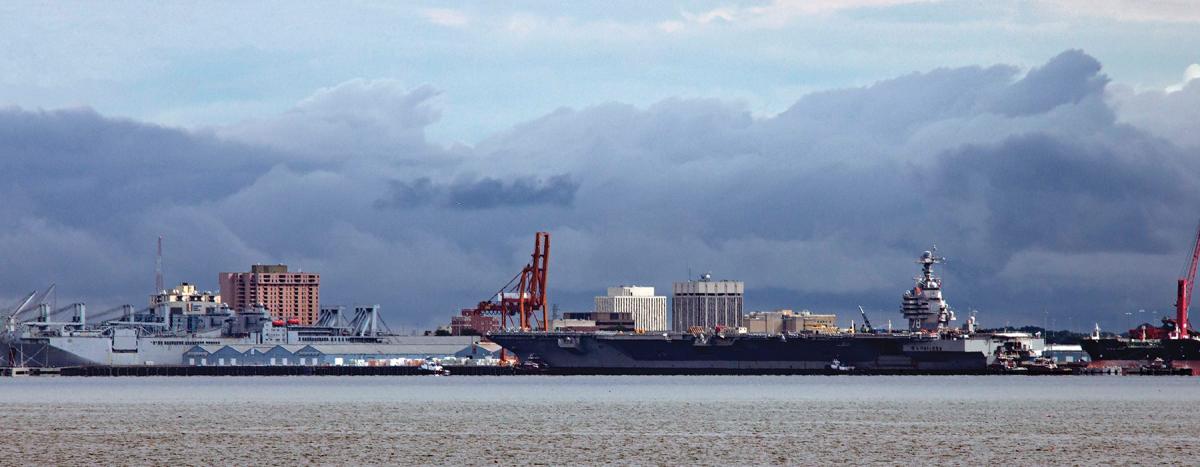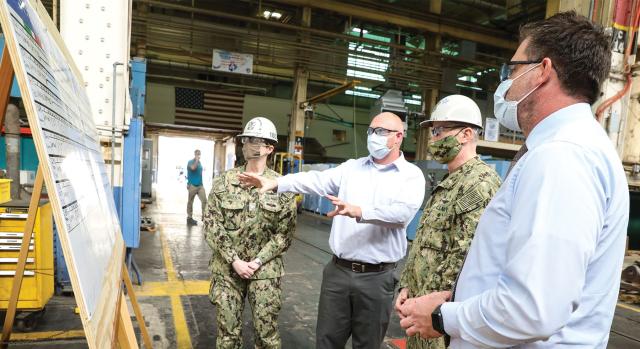Every day, the U.S. Navy keeps more than 100 ships underway and maintains constant vigilance in global hotspots. The Navy’s capacity to continue operating this way is under threat, not so much from a competitor as from its own inability to repair and maintain ships in a timely manner. This is not a new problem; shipyard productivity has been declining for years, while the time necessary to complete ship maintenance has continued to increase. The issue is becoming critical as more ships are being cycled through shipyard maintenance periods (availabilities).
Various proposals to solve maintenance delays point to greater expenditures, the idea being that more money will buy more repair capability, whether in people or infrastructure. But, as a former aircraft carrier commanding officer who has taken three different ships through both public and private shipyard availabilities, I strongly believe the problem is not with resourcing, but with the maintenance command-and-control (C2) structure. The current “management by committee” mind-set in shipyard maintenance undercuts project superintendents and robs them of precious time.
To get ship repair back on track, the maintenance enterprise must pivot to a C2 structure that clearly identifies the project superintendent as the supported entity and specifies that all other stakeholders serve in supporting roles, and that all shipyard functions—from ordering supplies to writing contracts to issuing security badges—support the superintendent. Two initiatives present an excellent opportunity to make such a pivot: performance-to-plan (P2P) and Naval Sustainment System–Shipyard (NSS-S). As a first step, the ship maintenance process owner—the commander of Naval Sea Systems Command (NavSea)—must elevate the P2P focus to the enterprise-wide C2 structure level and direct senior leaders to identify barriers to its implementation. The NavSea commander can then take the necessary steps to remove those barriers and synchronize the overall effort to focus on the appropriate supported and supporting relationships.
Why Scheduling Is Off
The ship maintenance enterprise includes dedicated professionals who work hard to control the cost, quality, and schedule of the work for which they are responsible. Their organizations oversee specific aspects of ship-repair availability—hull, mechanical, and electrical (HM&E) work, propulsion plant work, aircraft launch-and-recovery equipment (ALRE), and more. During planning, the shipyard project team, under the project superintendent, takes all these participants’ requirements and creates an integrated work schedule that should accurately scope the amount of time required to complete the availability.
But in practice, the project team’s schedule is often wildly off the mark and does not capture a realistic timeline, because the planning process incorrectly assumes the project superintendent is the sole driver of goals and milestones for the various supporting business offices, specialized shops and product lines such as valve repair facilities, and engineering codes. Instead, these supporting groups focus internally on their own equities and business practices, and they act as independent entities in a management-by-committee construct. The various ship-repair projects in the shipyard lose time by competing for the essential functions these organizations provide. Worse yet, shipyard leaders often task project superintendents and their deputies to support data calls from these external entities, thus drawing their focus away from their ship. Every time this happens, the original integrated work schedule is robbed of time that is not accounted for in the planning process. As a result, project superintendents cannot drive the progress of maintenance and adequately support their zone managers and deckplate supervisors.
The problem is not with the quality of shipyard workers, those who actually do the deckplate production work, often dubbed wrench turners. Like most ship commanding officers, I have seen firsthand the great work they do. Two years ago, at a very inconvenient time in the Optimized Fleet Response Plan cycle, the USS Harry S. Truman (CVN-75) had a significant electrical casualty that delayed her departure on deployment. The work to restore the system involved engineering expertise at NavSea headquarters to determine the casualty root cause and repair requirements, detailed repair work by Norfolk Naval Shipyard (NNSY) employees, parts needed from a private shipyard, and the restart of two different vendor production lines in the ship’s industrial base. Together, this group managed to complete in just nine weeks a repair that on normal timelines would likely have taken five to six months. Most of the NNSY workers took less than a handful of days off during the entire project. The maintenance professionals who work the daily production jobs on U.S. ships are dedicated to their work and the Navy.
Managers Must See the Big Picture
Wrench turners account for only a small portion of the overall manpower assigned to a shipyard availability. On any given day, very few people actually make physical repairs or modifications to a ship. The others (myself included) represent various levels of management in ship maintenance. Managers have good intentions and, as competent professionals, take cradle-to-grave ownership in their parts of the maintenance availability. They are very good at ensuring individual organizational priorities and timelines are supported on the deckplates and by project offices and shops. However, occasionally they fail to grasp where the ship’s organization fits in the overall effort. They forget that their primary job is not just to get work done, but also to support the project superintendent and overall schedule. By being good at what they do, they inadvertently shift the C2 structure away from a single project superintendent and toward maintenance by committee—which leads to shipyard workers having to answer to multiple bosses, while robbing the entire endeavor of the precious time needed to meet the big-picture schedule.
For example, if the manager of the circuit breaker shop on the shipyard has a quality escape in the production process, he or she faces a choice between supporting the organization’s equities or the greater shipyard effort. The manager can prioritize the shop (and slow down work in the various projects in the shipyard) by shutting down the product line and remediating. Or the problem can be mitigated in place on board the ship(s) while keeping people and equipment working to complete the project(s). The decision is based on a fundamental view of whether the manager believes the shop is supported or supporting. If the circuit breaker shop is viewed as the supported entity, the manager will take the easier route and shut down the shop and quickly remediate. But if the manager understands the mission is to support on-time completion of the various maintenance availabilities on the shipyard, he or she will take the more difficult and longer route of mitigation in place—and not rob time from the project superintendents.
Other examples of robbing time from projects include standard business practices such as 10-day turnarounds for contractor access badges from shipyard pass-and-tag offices, and more than 14-day turnarounds for contracts on growth work discovered during availabilities. Codified business practices such as these are great for organizing individual offices, but they do not support the enterprise’s mission of on-time project completion.
Managers must inculcate a supporting mind-set throughout their organizations, whether it is a rigger shop on the yard or a nuclear engineering code at NavSea. If they make decisions based on what saves the project superintendents’ time rather than what is most convenient for individual entities, they can attack the enterprise-wide problem of on-time project completion.
All Eyes on the Timeline
The previously discussed aircraft carrier (CVN) electrical casualty was repaired so quickly because the entire team acknowledged that time was the limited resource. The fleet commander made it clear to the team that getting the ship underway on deployment was his top priority. His involvement served as a forcing function that required everyone associated with the repair to abandon the management-by-committee mind-set and understand that we were all supporting the project superintendent. As a result, we saw the removal of all sorts of typical barriers to progress. Shops prioritized and more efficiently sequenced repair work, contracts were signed faster, engineering codes turned around decisions much quicker than normal. We were even able to improve transportation and delivery timelines for required parts—all without any significant increase in overtime costs.
Notable historical successes in aircraft carrier maintenance are largely attributable to having thought of time as a limited resource. Maintenance availabilities for carriers from two locations have routinely been completed on time: Yokosuka and San Diego. Puget Sound Naval Shipyard (PSNS) typically oversees the selected restricted availability for the CVN assigned to the forward deployed naval forces (FDNF) and the planned incremental availabilities for various CVNs berthed at San Diego. These away-from-home-port (“expeditionary”) availabilities have been successful despite the fact that they involved extensive reach-back to PSNS headquarters for engineering and production-shop support. One reason is that the Navy devotes more resources to these availabilities, especially the FDNF carrier. Another is that there is always a forcing function from the fleet commander when it comes to maintaining the ships that support national defense priorities in the western Pacific. However, the real secret to the success of these availabilities is that time savings were baked into the plan from the start.
That time-saving aspect of these expeditionary projects is attributable to three important factors. First, they did not have the distraction of multiple projects and changing priorities drawing away manpower and resources, as they would in their home shipyards. Second, as any deployed sailor understands, these craftsmen planned to be away from home for a predetermined period, and their families expected them to be back on time. No forcing function is more effective than an individual’s desire to get home; workforce productivity increases as the deadline nears for returning home. Finally, because of the higher costs of expeditionary availabilities, management kept a wary eye on anything that could slow production. As a result, contracting timelines were more closely tracked, there tended to be fewer requests for data or other distractions from external entities, and shops back home were less likely to allow their internal deficiencies to affect the expeditionary project’s schedule. In other words, management more closely adhered to the correct C2 structure for these availabilities.
The flip side of the expeditionary model explains how the Navy has slipped into a mind-set of discounting time as a resource for work done at home shipyards. The same craftsmen just described may not be as incentivized toward productivity at their home shipyards as when they are away, because they go home every night. With a backlog of ships waiting to enter the shipyard, the work will always be there. One of the many levels of management supporting their project might take a few extra days to provide them with a decision, or they could be pulled off of one ship in the middle of their work and sent to another for a higher priority.
Whenever conditions and incentives for high productivity are ignored or dismissed, time as a limiting resource is disregarded on an organizational level. It is easier to become complacent about C2 and undercut the project superintendent when doing maintenance at a home shipyard. Without the entire organization pushing to complete projects on time, there is no incentive to stay the course. I have often joked that CVN maintenance scheduled for Norfolk could be performed faster if we moved the ship and an expeditionary repair team to Mayport, Florida. Such a move would be inefficient and cost-prohibitive, but from the perspective of on-time completion, the idea has merit. Of course, a better solution would be to reproduce the mind-set and sense of urgency of an expeditionary availability at home through strict adherence to supporting and supported relationships.
Widen the P2P Aperture
The Navy’s ongoing P2P initiative provides an ideal opportunity for the service to pivot to an operational C2 structure in the maintenance enterprise. Shipyard P2P is a data-driven structured framework that is already improving throughput in various product lines and increasing information-sharing between public and private shipyards. However, the current scope of the P2P effort focuses too narrowly on gaining efficiencies at the level of individual shops and business offices. Right now, from a ship-repair-project perspective, shipyard P2P looks like the next version of the management methods Lean Six Sigma and Continuous Process Improvement. If P2P is simply overlaid on the current way of doing business, the problem is not attacked at the right level. In fact, a tight focus on shop and office efficiency could very well exacerbate the time problem and reinforce the tendency to manage by committee. Instead, the scope must be expanded and the organizational mind-set must be changed. A more effective approach is to widen the P2P aperture to include a more holistic view of the maintenance enterprise at the project level.
The NavSea commander and senior leaders must expand the focus of the P2P effort by baselining project superintendents (and their sailor/shipyard worker teams) as the supported entities and all others as supporting. Some might counter that this relationship is already acknowledged, even codified, but poor results through the years prove that the Navy does not routinely adhere to it. Pivoting an organizational mind-set requires change management at an enterprise level, and it will be difficult. But previous successes at CVN expeditionary availabilities show what is possible.
All management levels can be educated by drawing on the lessons of those successes. With the appropriate mind-set, time savings can be instilled into plans for ship maintenance and repair. A properly supported project superintendent should expect consistent timelines from product lines, quick turnarounds on engineering decisions, and minimal impacts from human resourcing actions—leaving plenty of time to focus on completing the scheduled work.
All managers must relentlessly drive the ship-repair enterprise. With this higher-level focus, P2P will be a powerful tool that defines performance gaps, identifies high-impact actions, removes barriers, and drives measurable performance improvements in ship maintenance. In project team meetings, success will be obvious when product-line and engineering participants no longer bring up what they need and instead focus on what the project superintendent needs.





